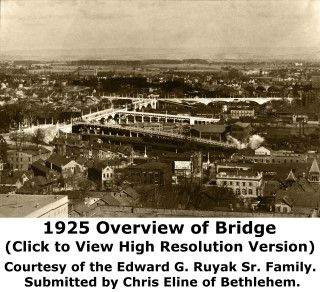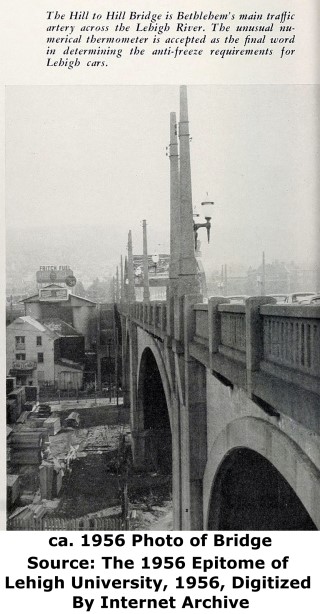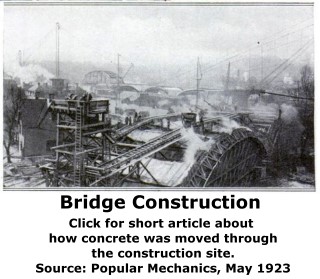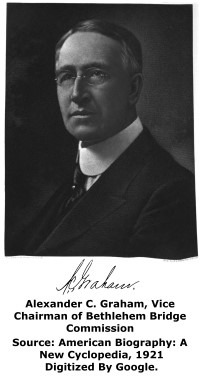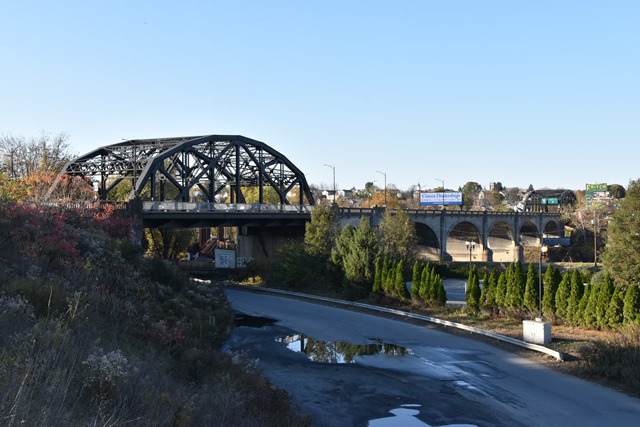We Recommend:
Bach Steel - Experts at historic truss bridge restoration.
BridgeHunter.com Phase 1 is released to the public! - Visit Now
Hill To Hill Bridge

Primary Photographer(s): Nathan Holth and Rick McOmber
Bridge Documented: May 30, 2010 and November 2, 2019
Bethlehem: Lehigh County, Pennsylvania and Northampton County, Pennsylvania: United States
Metal 8 Panel Rivet-Connected Hudson Through Truss, Fixed and Approach Spans: Concrete Closed Spandrel Deck Arch, Fixed
1924 By Builder/Contractor: Rodgers and Hagerty of New York, New York and Engineer/Design: Clarence W. Hudson
1990
171.0 Feet (52.1 Meters)
1,607.0 Feet (489.8 Meters)
40 Feet (12.19 Meters)
2 Main Span(s) and 10 Approach Span(s)
39037800740000

View Information About HSR Ratings
Bridge Documentation
View Archived National Bridge Inventory Report - Has Additional Details and Evaluation
View Historic American Engineering Record (HAER) Documentation For This Bridge
HAER Data Pages, PDF - HAER Original Plan Sheets, PDF
View the Central Bethlehem Historic District Nomination
Original Nomination -
Contributing Structures List -
Boundary
Increase
View A Historical Article About The Bridge's Construction
View A Biography of Bethlehem Bridge Commission Vice Chairman Alexander Graham
View A Detailed Booklet Discussing The Hill To Hill Bridge's History And Design
Guide To The Bridge
Adapted From Historical Booklet
The above diagram should help viewers interpret the descriptions and photos of this bridge. The different sections of the bridge are drawn and labeled, with those sections that were demolished and not present when this bridge was photo-documented shown highlighted in red. The orange section shows where the bridge's north approach was added, which today is part of the main bridge and the primary means of crossing the bridge. Below, is a photo of the bridge shortly after it was completed. Click to load a high quality version of the photo that shows exceptional detail. This photo shows the bridge as originally configured.
Overview of the Bridge
The Hill To Hill Bridge is one of the most unique bridges ever constructed. It consists of a high level bridge that is composed of a combination of steel through truss and concrete closed spandrel deck arch spans, with numerous access ramp bridges branching off from the Main Bridge in a number of locations. One might think of the Hill to Hill Bridge as a Y bridge that instead of having a fork in the road at one end of the bridge, this bridge has multiple forks located in different places on the bridge. This design alone makes the bridge unique and noteworthy. However, the bridge is also noted for its truss spans which have a unique truss configuration described in the next section, as well as the overall size of this bridge which is quite large. The bridge represents a significant engineering achievement that required considerable creativity to overcome many unique obstacles associated with the location.
The Hill To Hill Bridge was built under the direction of the Bethlehem Bridge Commission. The Hill To Hill Bridge was designed by Clarence W. Hudson. Clarence Hudson's past included being the design engineer for the Phoenix Bridge Company from 1892 to 1906. For the Hill To Hill Bridge, Hudson had great design challenges because of numerous railroad facilities under the bridge that could not be reconfigured, as well as the challenges of connecting a bridge that would run in a high level format over multiple streets, two bodies of water, and an island to the surface streets below. The contractor for the bridge was Rodgers and Hagerty of New York, New York. The truss spans were subcontracted to Bethlehem Steel Company of Bethlehem, which is appropriate given the fact that the Bethlehem Steel works is near to this bridge.
Today, although some of the bridge's ramps have been removed or closed, the remainder of the bridge remains functioning and in good condition. The bridge is a contributing resource to the Central Bethlehem Historic District. The bridge also crosses over the Lehigh Canal Historic District.
Thanks to Chris Eline for providing HistoricBridges.org with a highly detailed booklet that discusses the history and design of the Hill to Hill Bridge and includes several historical photographs. HistoricBridges.org has digitized the book and made it available for download.
The Truss Spans: Individually Nationally Significant
The two 171 foot truss spans are individually significant as the only two known examples of a unique and bizarre truss configuration that is today known as the Hudson truss, named after Clarence W. Hudson, who designed the Hill-To-Hill Bridge. The design was created by Hudson to accommodate an unusual design requirement of the Hill-To-Hill Bridge. First, truss spans were needed in two locations on the bridge, because their were railroads underneath the bridge that would be obstructed if a concrete deck arch span were constructed as was done on the majority of the bridge. A through truss span in contrast put the superstructure above the deck, providing the maximum clearance and space underneath the bridge for the railroads. However, another problem is that an access ramp was needed to run from the ground level up to the bridge and it needed to intersect with the bridge at the same point as where the southern truss span was located. Indeed, the ramp needed to intersect the bridge at the center of the truss span. Therefore, Hudson needed a through truss configuration that did not have any diagonal members at the center of the truss, so that drivers could literally drive through the truss web between the vertical members to access the bridge. Hudson designed a truss where the lower portion of the central panels of the truss does not have any diagonal members, which accomplished this unique need.
The truss spans on the Hill To Hill Bridge are the only known examples of this bizarre Hudson truss configuration. As such, the truss spans of the Hill To Hill Bridge individually have national significance as the only example of their unique and creative design.
Preservation Comments
With so few historic bridges in Pennsylvania being preserved, PennDOT deserves to be thanked for choosing to rehabilitate this historic bridge for continued heavy vehicular traffic, rather than demolishing and replacing it with a slab of concrete. Because of the most recent rehabilitation, the Main Bridge, the ramps at the southern end of the bridge and the Main Street Branch Ramp all remain in excellent condition. Original concrete balustrade railings have been left in place on the bridge, while being supplemented with modern New Jersey barriers between the sidewalks and roadway for the safety of both the bridge and vehicles. Replica concrete balustrade railing was placed in the areas where ramps were removed. With the exception of those ramps which have been removed, and the replacement of pedestrian railing on the truss spans, the bridge appears to retain excellent historic and structural integrity. The bridge remains standing today and a beautiful and nationally significant historic bridge.
The West Side Ramp has been closed to through vehicular traffic, but has been left in place, and appears to still be used for parking. This closure and reuse is not detrimental to the historic integrity of the bridge, as long as the ramp is left in place and not demolished.
The only areas to be critical of this bridge's rehabilitation was with the removal of the 2nd Street and River Street access ramps. Even if these ramps were not being used, or needed to be closed to traffic because of safety issues that would likely be associated with having intersections in the middle of a bridge, these ramps should have been closed off and left in place for their historic significance, perhaps in a manner similar to the West Side Ramp. The loss of these ramps has destroyed some of the key features of this bridge that make it so unique. When these ramps were in place, the bridge retained its spider-like configuration, that of a central Main Bridge, with ramps branching out all around. Today, with these ramps removed, the bridge only has ramps branching out at the ends. This gives the bridge a much different appearance and feel. The greatest loss however was the removal of the 2nd Street Ramp. With the removal of this ramp, there is no visual explanation to anyone visiting this bridge as to why the unusual Hudson truss spans are present on the bridge. The unique scene of a ramp intersecting a bridge in the middle of a through truss span has been lost. Even if the entire ramp could not have been left in place, it would have been nice to leave the first couple spans of the ramp leading from the through truss span in place, so that the function and appearance of the truss would not have been affected.
Information and Findings From Pennsylvania's Historic Bridge InventoryDiscussion of Bridge The 13 span, 1607'-long bridge consists of 12 reinforced concrete arch spans and a single steel thru truss span. It is located in the Central Bethlehem Historic District and is a listed contributing resource in the district nomination. Discussion of Surrounding Area 'The bridge carries a 4 lane road with one sidewalk over the Lehigh River, the Lehigh Canal, Conrail, and three local city streets. The Hill to Hill Bridge spans the Lehigh Valley in the City of Bethlehem, and is in the Central Bethlehem Historic District (listed 5/5/72, boundary increase 11/7/88). The large district has a period of significance from 1845 to 1938. The bridge also spans over the Lehigh Canal Historic District (listed 12/17/79), which follows the right-of-way of the abandoned canal that operated from 1840 to 1931. Bridge Considered Historic By Survey: Yes |
This bridge is tagged with the following special condition(s): Unorganized Photos
![]()
Photo Galleries and Videos: Hill To Hill Bridge
Structure Overview
Original / Full Size PhotosA collection of overview photos that show the bridge as a whole and general areas of the bridge. This gallery offers photos in the highest available resolution and file size in a touch-friendly popup viewer.
Alternatively, Browse Without Using Viewer
![]()
Structure Details
Original / Full Size PhotosA collection of detail photos that document the parts, construction, and condition of the bridge. This gallery offers photos in the highest available resolution and file size in a touch-friendly popup viewer.
Alternatively, Browse Without Using Viewer
![]()
Structure Overview
Mobile Optimized PhotosA collection of overview photos that show the bridge as a whole and general areas of the bridge. This gallery features data-friendly, fast-loading photos in a touch-friendly popup viewer.
Alternatively, Browse Without Using Viewer
![]()
Structure Details
Mobile Optimized PhotosA collection of detail photos that document the parts, construction, and condition of the bridge. This gallery features data-friendly, fast-loading photos in a touch-friendly popup viewer.
Alternatively, Browse Without Using Viewer
![]()
Southbound Crossing of the Bridge
Full Motion VideoStreaming video of the bridge. Also includes a higher quality downloadable video for greater clarity or offline viewing.
![]()
2019 Additional Unorganized Photos
Original / Full Size PhotosA supplemental collection of photos that are from additional visit(s) to the bridge and have not been organized or captioned. This gallery offers photos in the highest available resolution and file size in a touch-friendly popup viewer.
Alternatively, Browse Without Using Viewer
![]()
2019 Additional Unorganized Photos
Mobile Optimized PhotosA supplemental collection of photos that are from additional visit(s) to the bridge and have not been organized or captioned. This gallery features data-friendly, fast-loading photos in a touch-friendly popup viewer.
Alternatively, Browse Without Using Viewer
![]()
Maps and Links: Hill To Hill Bridge
Coordinates (Latitude, Longitude):
Search For Additional Bridge Listings:
Bridgehunter.com: View listed bridges within 0.5 miles (0.8 kilometers) of this bridge.
Bridgehunter.com: View listed bridges within 10 miles (16 kilometers) of this bridge.
Additional Maps:
Google Streetview (If Available)
GeoHack (Additional Links and Coordinates)
Apple Maps (Via DuckDuckGo Search)
Apple Maps (Apple devices only)
Android: Open Location In Your Map or GPS App
Flickr Gallery (Find Nearby Photos)
Wikimedia Commons (Find Nearby Photos)
Directions Via Sygic For Android
Directions Via Sygic For iOS and Android Dolphin Browser
USGS National Map (United States Only)
Historical USGS Topo Maps (United States Only)
Historic Aerials (United States Only)
CalTopo Maps (United States Only)


